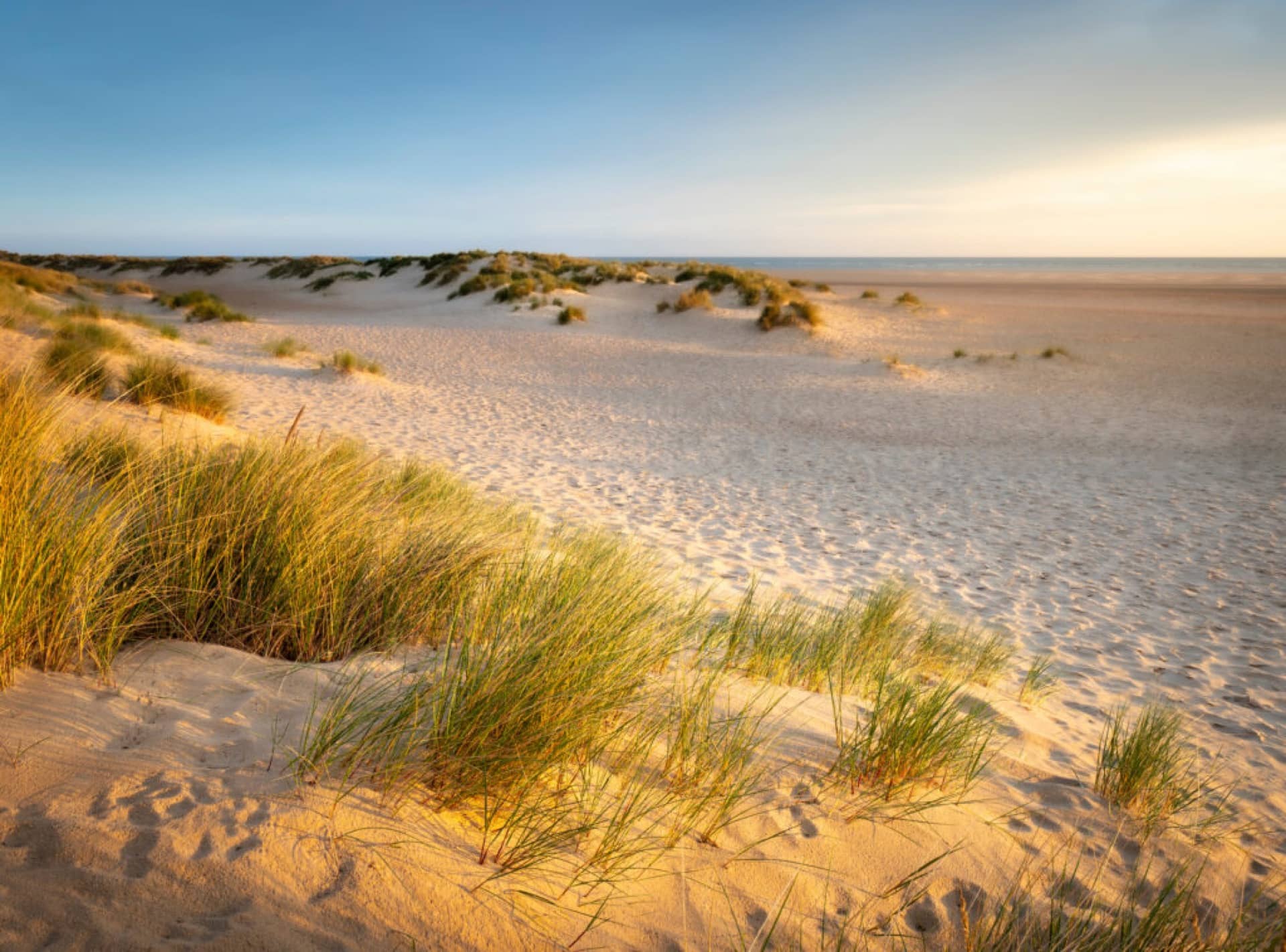
Sunrise to moonrise
Time outside in winter light is a fantastically transformative, mood lifting experience. Make the most of it by bookending your day with a sunrise to moonrise encounter in Great Yarmouth, then get cosy in a pub when darkness falls!
Head for the beach at North Denes, where sea winds gust in whirling sand patterns across the shore. Dog walkers and romantics wander in salty solitude, clearing the mind in newly minted air. With summer crowds gone, the Norfolk coast feels like it’s all yours, so wrap up for an invigorating walk where tussocks of coarse Marram grass offer a uniquely barren beauty during the luminous days of winter.
Be first to greet the morning by going down to the sand before sunrise. Nestle in the dunes, sheltered from the North Sea wind, and watch the pearly sky flush with promise for the new day. Why not take breakfast with you? A flask of hot coffee and delicious Pastéis de Nata from one of Great Yarmouth’s Portuguese stores make a fine treat.
Embrace a whole day of ethereal light and stay until the bronze glow of the sinking sun sets Great Yarmouth’s rooftops aflame and murmurations of starlings wheel across the pewter sky.
You may see a full moon rising from the crescendoing tide. September’s Harvest Moon shines bright and buttery while the hungry Wolf Moon of January rises with the constellations, glittering over a vast horizon, a signal of hope in the midnight of the year.
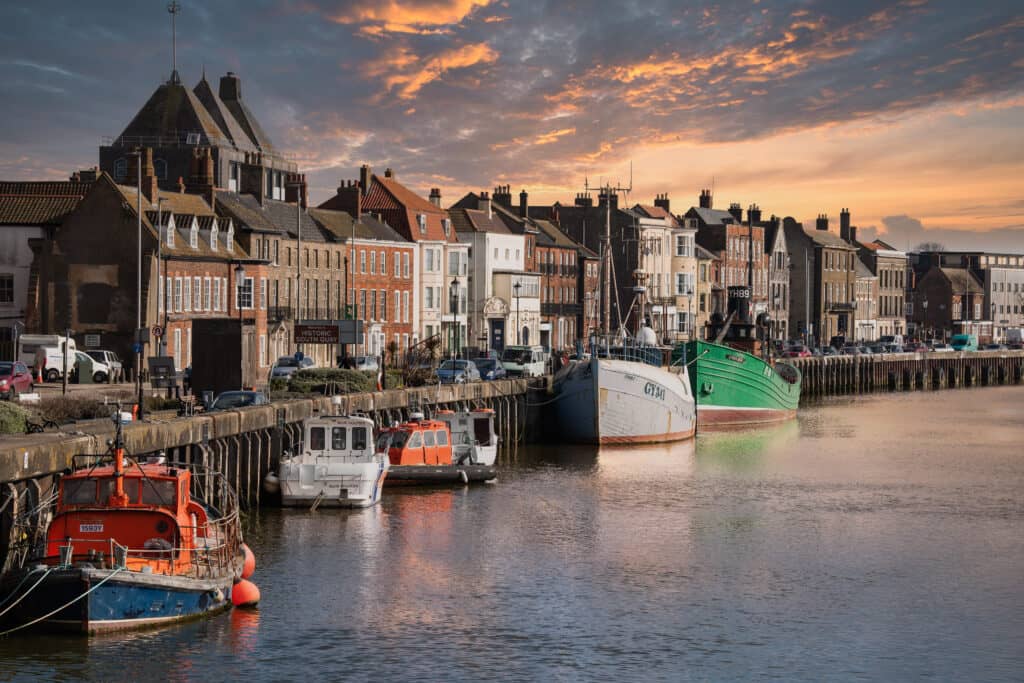
Black Beauty Begins
Anna Sewell wrote only one book. Published by Jarrolds of Norwich in 1877, this beloved story has never been out of print. Translated into over 50 languages, it’s sold more than 50 million copies and been filmed and televised many times. It is, of course, Black Beauty.
Born in Great Yarmouth on the Norfolk coast in 1820, Anna was home schooled while her parents moved around seeking work. Painfully disabled due to a teenage accident, she needed a pony and trap for mobility and developed a deep empathy with horses. So much so, her book was written in Black Beauty’s own voice. Placing the reader in the body and mind of a horse gives Anna’s progressive plea for compassion a lasting power, still packing a huge emotional punch.
A great children’s classic, Black Beauty; His Grooms and Companions, the Autobiography of a Horse was originally intended as a guide for people who worked with horses “to induce kindness, sympathy, and an understanding treatment”. Anna had witnessed Victorian England’s animal cruelty and particularly hated ‘bearing reins’ which forced carriage horses to arch their heads so fashionably high they could barely breathe.
Mostly bedridden with declining health, Anna took six years to complete Black Beauty, dying five months after publication. The horses pulling her funeral cortege had the bearing reins removed. Partly due to the outcry raised by Anna Sewell’s novel, their use was eventually discontinued.
You can visit Anna’s birthplace, now a sweet tea room, near St Nicholas on Church Plain.

Walking Through Time
Walkers love Norfolk’s stunning coastal paths. If you’re one of them, you’ll be following in the footsteps of people who’ve walked here for hundreds of thousands of years.
In fact, actual footprints were discovered at Happisburgh, left in the ancient estuary mud by people roaming this land before the Ice Age. Over 850,000 old, it’s possible they were made by nomadic hunters, following migratory animals such as mammoths, bison, rhinos and deer in the days when Britain was connected to mainland Europe by a great plain, similar to East Africa’s Serengeti. Or perhaps searching the mudflats for seaweed and shellfish.
Amongst the earliest evidence of humans in Britain, these amazing footprints were found accidently during a geophysics survey in 2013. Around 50 footprints were discovered, two showing details of toes. Approximately five individuals were identified, both adults and children. Their footprints were carefully photographed in 3D before being washed away forever by the tides of the North Sea, lost deep in time.
The course of the river where our ancestors once walked has now moved south and is today known as the Thames. Standing on the flint shingle banks, imagine the rolling waves as a vast flowing grassland of creeks and scrub allowing direct passage from Norfolk all the way to Africa.
Close your eyes and listen intently. The hyena and bison have long gone, but sometimes the sea sounds like swishing grass and wind like the mournful trumpet call of a mammoth.
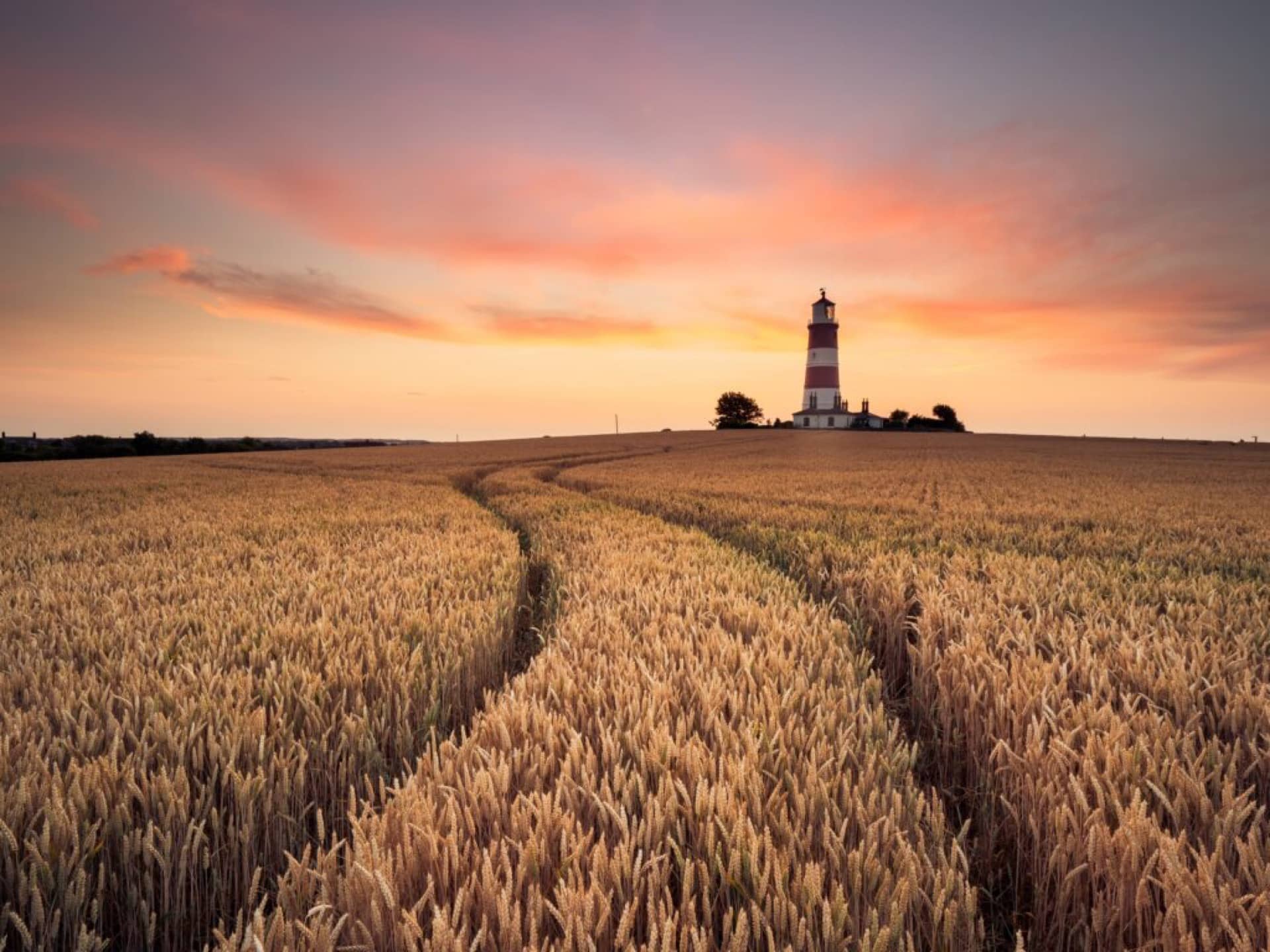
The Legless Ghost of Happisburgh
Happisburgh is a place of shifting boundaries, land and sea, time and space, life and death. Even the name changes, depending on where you’re from. Those in the know say ‘Haze-burr’, anything else just sounds strange. And talking of strange things, here’s a gruesome ghost story for winter nights.
There were once some farmers heading home for supper and a flagon of ale. Near Cart Gap they saw a figure lurching towards the village, clutching a filthy sack. He seemed to be a poor hunch-backed sailor but something was very wrong. Peering through the gathering dusk the farmers were struck with sickening horror. That was no hump, but a nearly severed head, hanging by a single ribbon of flesh, thudding against the spectre’s spine as it walked. Yet how did it walk? For the grisly creature had no legs!
Terrified, the farmers hotfooted it to the inn. (We’d wager the phantom wasn’t the only one completely legless that night!) After more sightings, the gruesome ghost was followed to the grassy triangle where Whimpwell Street meets Whimpwell Green and Coronation Road. There it vanished into a well. A brave young man lowered himself down, groping in the gloom. There was the sack! And inside were sailor’s boots…with sailor’s legs still inside! The well was drained. And there was another sack, containing a torso in sailor’s uniform, its hideous skull dangling by a strip of rotting flesh.
Smugglers’ tale or true? We dare you to investigate…

Deep History
On a winter walk at West Runton you’ll probably see a few happy dogs racing on the beach. Yet go back about 600,000 years and you’d be more likely to see elephants. Actually, Harold and Margaret Hems did see one, in December 1990. At least, they saw its pelvic bone, poking out of the cliff after a violent winter storm. Five years later a full excavation unearthed the oldest and largest Steppe Mammoth skeleton ever found in the UK. Standing at 4m tall and weighing 10 tonnes, this gigantic prehistoric mammal has become a local legend.
A towering creature, the Steppe Mammoth – Mammuthus trogontherii – roamed this ancient place with rhino, bison, beaver, hyena and also stone age settlers. But they shared a very different view to the one we see today. In fact our ancestors could have walked from Norfolk to Holland without getting their feet wet because the choppy North Sea was a land of rivers, grasses and savannah. Imagine that as you gaze at the horizon!
The mammoth’s near complete but fragile skeleton is preserved by Norfolk Museum Services. You can see part of it in Cromer Museum and find out more at West Runton Beach Café’s learning hub.
When winter gales scour the Norfolk coast and chunks of eroding cliff crumble down, a walker might scout a pre-historic fossil, perhaps a fragment of deer antler or mysterious mammal bone. But no one has been as fortunate as Mr and Mrs Hems. At least, not yet…

Norfolk’s Great Chalk Reef
Not all reefs are made of coral! A stone’s throw from the Norfolk shore, just under water, is the largest chalk reef in Europe, possibly the world.
The Cromer Shoals Chalk Bed was formed 100 million years ago when dinosaurs roamed the earth. Shaped by meltwater at the end of the last Ice Age it’s 20 miles long, 6 miles wide and teeming with life. Stretching from Weybourne to Happisburgh, the reef is home to over 350 different species of plants and animals, some found nowhere else in the world. It’s significance as one of the England’s most ecologically important marine habitats was recognised in 2016 when the reef was designated a Marine Conservation Zone (MCZ).
Norfolk’s remarkable reef is home to edible and velvet crabs, lobsters, starfish, jellyfish and some fabulously unusual creatures such as the Atlantic ancula sea slug, leopard spotted goby (a shy fish) and strawberry anemone (scarlet with tiny green spots).
On a winter beach walk when the tide’s out you’ll see chalky hollows studded with flint, where rock pools provide a safe haven for winkles, limpets and strange dark red jelly-like blobs. These are beadlet anemones, gorgeously jewel coloured, highly territorial sea-creatures whose soft bodies conceal short tentacles with a potent sting.
To experience the full expanse of the chalk reef you need calm seas, low tides and an elevated position. There’s a great vantage point on Skelding Hill, reached by walking north from Sheringham towards Weybourne on the cliff top coastal path.
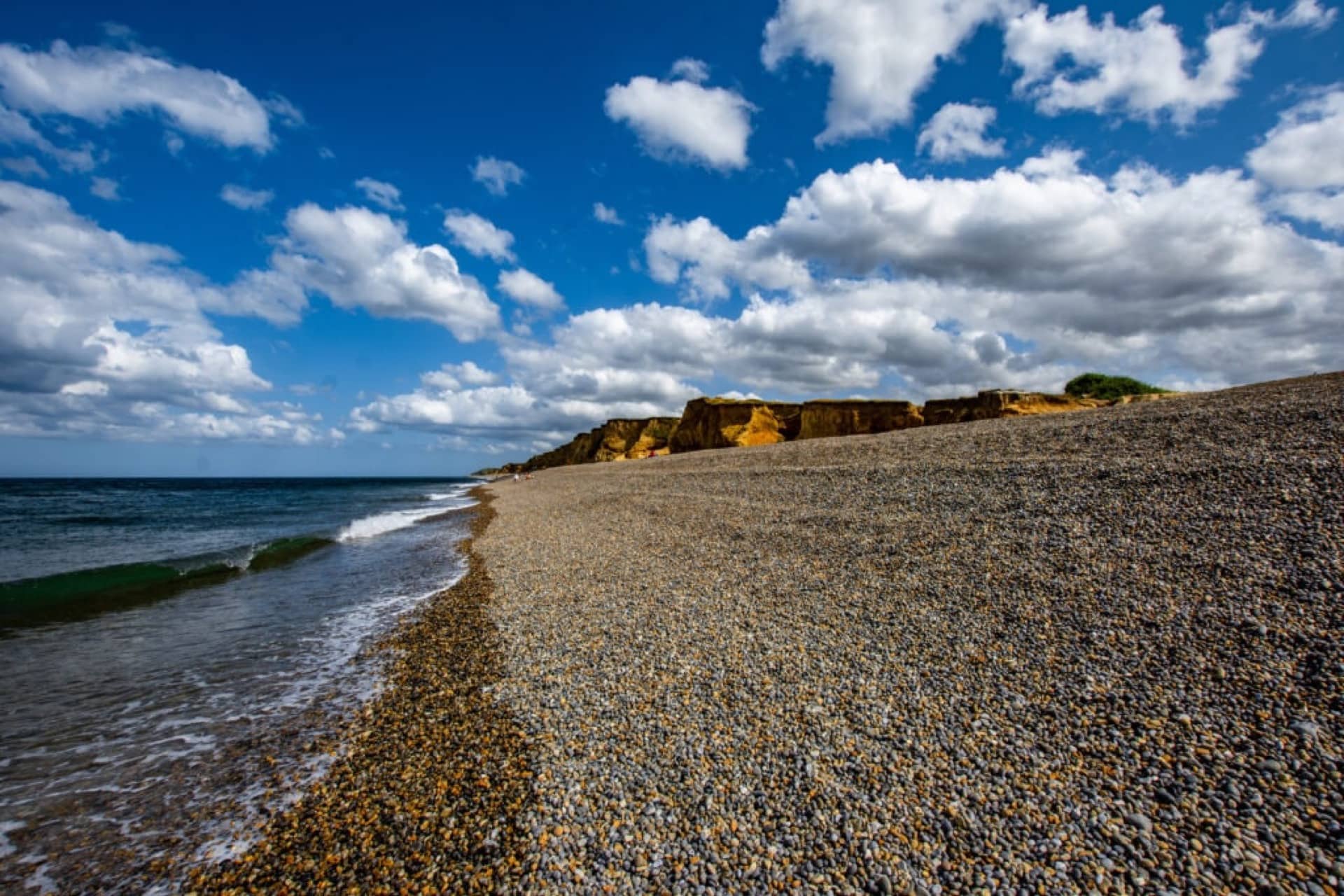
People of the Pebbles
Tales of smugglers run through Norfolk like ribbons of moonlight. And some are stranger than others…
Seafaring free traders worked with onshore accomplices unloading illicit cargo, spiriting it inland on waiting carts. The shingle sweep of Weybourne beach had scarce hiding places and a keen customs officer watching from the sandy cliffs had a good chance of spotting unusual nocturnal activity and quickly raising the alarm.
So the cunning landing parties came up with an ingenious trick. Stealthily, they buried themselves in pebbles up to the neck, stock still in the shadows of the night. When the coast was clear, a whistled signal told the men to rise up from their shingle hollows like the returning dead and empty the boats. It’s said a local landowner, Mr William J. Bolding, turned a blind eye to the comings and goings in return for a hefty share of the contraband.
But those days are long gone. Or are they? For it’s said on nights when the moon is full, a low whistle is heard in the village of Weybourne and it belongs to a dead man walking. Smuggler John Smythe was late back to the beach after visiting his lover, the inn’s landlady. Believing him caught, his companions rowed away. When John whistled for them, the watching revenue officers sprung out. Cornered, John waded into the sea where he drowned, still whistling in vain hope of rescue.
Which ghosts might you meet on the winding paths of Weybourne?
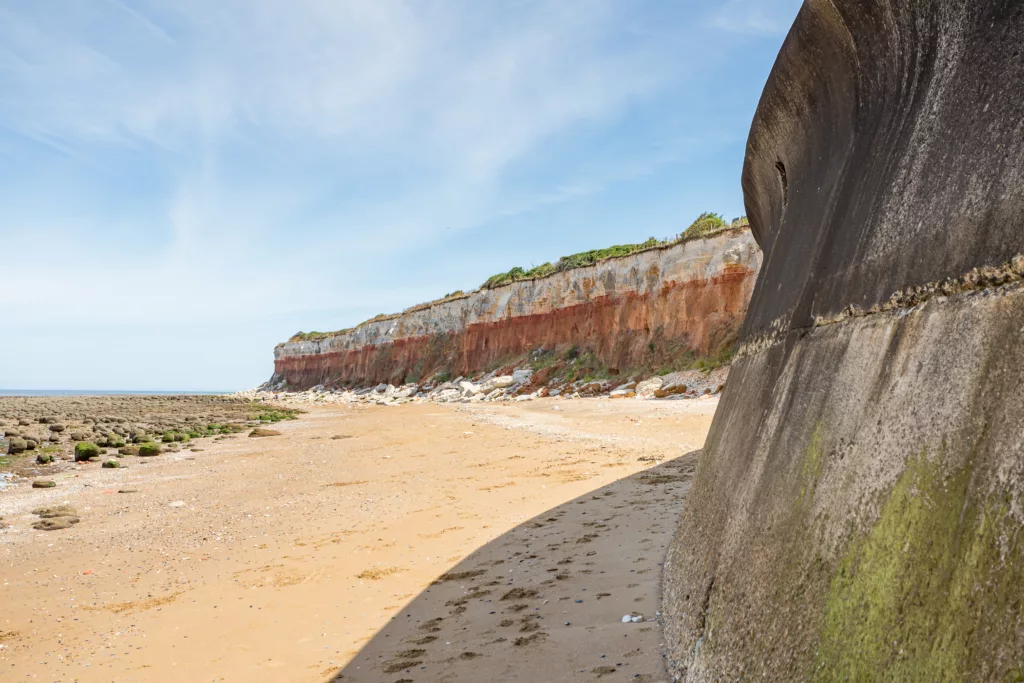
Seawall Sketch
There is so much to inspire artists in Norfolk. In his poem ‘Norfolk’, John Betjeman wrote of ‘a whispering and watery Norfolk sound’. Immerse yourself in that ‘Norfolk sound’ by sitting on the crest of a seawall. Sea walls are engineered to protect the dynamic nature of the coast from erosion by reflecting the power of the waves back to the sea. They mark humanity’s line of defence between land and sea, a tension between elemental forces and human endeavour.
Hundreds of miles of Norfolk’s green embankments maintain an uneasy truce with the waves, for this land is borrowed from the sea and the sea demands it back. So from the Wash all along the coast to the eastern end of Salthouse Marshes, sea walls abound. Follow any footpath alongside a seawall and walk through a windswept world of movement and light. Where it’s safe, perching aloft gives superb views, or tuck down the slope out of the wind. Look how light pierces banks of cloud, spearing fields with brilliant shafts of sunlight like rays from a spaceship, most dramatic at dawn and dusk in the winter months. Huge skies become one with land and sea, a pearly symphony of elements. Breezy days are made for kites, dancing above golden dunes shimmering with silvery green marram grass. Watch them dip and turn, riding in the wild air like gulls. Take a hot drink and find a sheltered spot to sit down with a drawing pad and create your memories.

Northerly Wind at Cley Beach
Charge up your Vitamin D, boost your immune function and re-charge your serotonin levels; learn to love the outdoors in winter! Head to Cley-next-the-Sea, where Norfolk’s big skies are at their most spectacular. Arctic winds race across the North Sea unhindered until they slam into Norfolk, the first land mass to break their howling path from the far north. Yes, it’s cold. But it’s also awe inspiring.
Storm chasers will see a stunning elemental clash of land and sea. Stride into the wind towards the shingle ridge at Cley Beach. Pebbles, rounded and polished under your boots skitter back as you cross the divide between shelter and storm. Breaking the ridge, a wild world opens out in front of you; a maelstrom of iron grey sea, waves slashed with white foam, crashing onto the shore. Breakers push and shove the clattering stones, relentlessly moving them along the coast. Embrace the majesty of nature in winter, layer up well and hunker down with a thermos of something hot, protection against the biting cold. You’ll meet a few other hardy souls out in the exhilarating wind. Photographers and birdwatchers, looking for gannets, piratical skuas riding the tempest from the far north and rare sightings of puffins, blown off course by driving winds. This season is a time for movement, change and survival. When the wind’s pierced every layer of clothing, time to warm up in Cley village. Leave the beach to its storms, take the memories with you.
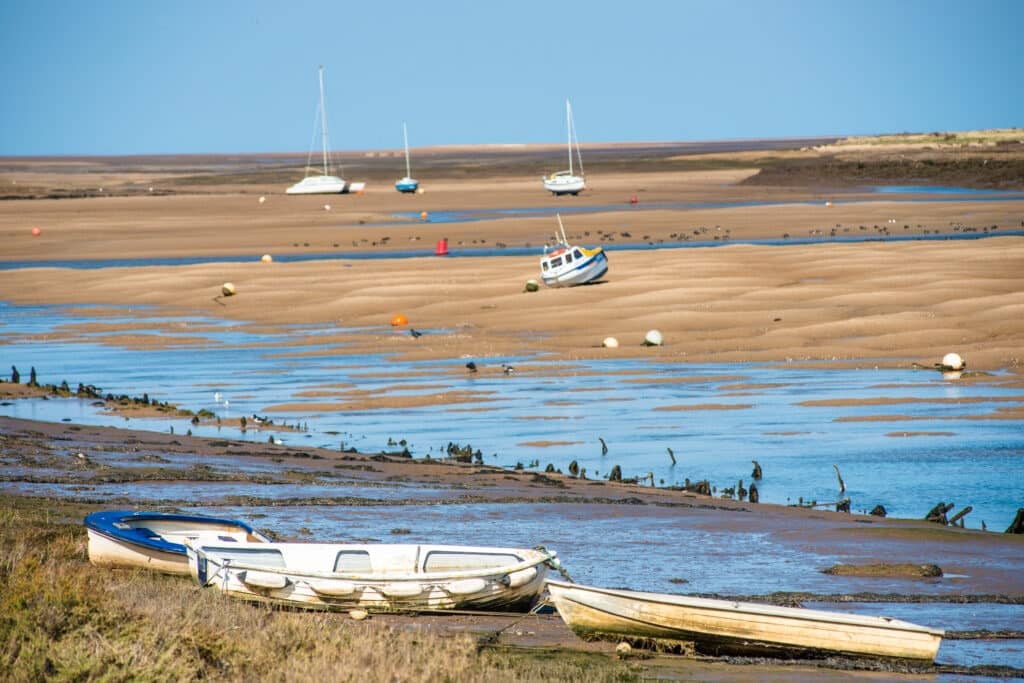
Dawn Flight
It’s bitterly cold. Yet January is an excellent time to head outside and witness one of Britain’s most magnificent dawn experiences. Huddle in the shelter of sand dunes or a Wells beach hut. And wait.
Light glimmers in the east. Day is breaking and with it, an awakening. Ragged cries spike the dark silence. Slowly, quietly it begins. Excitement mounts in rousing crescendos, spreading among thousands of wildfowl, restless on the cold mud.
And then they rise. A wild chorus fills the air, elemental and unrelenting. Thousands of pink footed geese lift almost as one continuous wave of breathtaking joy. Great skeins make V patterns overhead, calling all the while, formations shaping the fading dark. Over the watchers they fly inland, hungry from their night fast, searching for sugar beet tops in newly harvested fields.
In the not too distant past, wildfowlers lined up here, guns loaded to shoot the birds down. Professional wildfowling guides were a cutthroat bunch, guarding their secret shooting locations well. Around this time, Sir Peter Scott, son of the polar explorer Robert Falcon Scott, wrote his book Morning Flight, describing being here as a pilgrimage. His love of such glorious natural spectacle surely informed his work as a conservationist. He established the Wildfowl and Wetlands Trust (WWT) in 1946 and later co-founded the World Wildlife Fund.
And so, morning has come and the geese are off to find breakfast. Time you head back to the warmth of Wells and do the same!
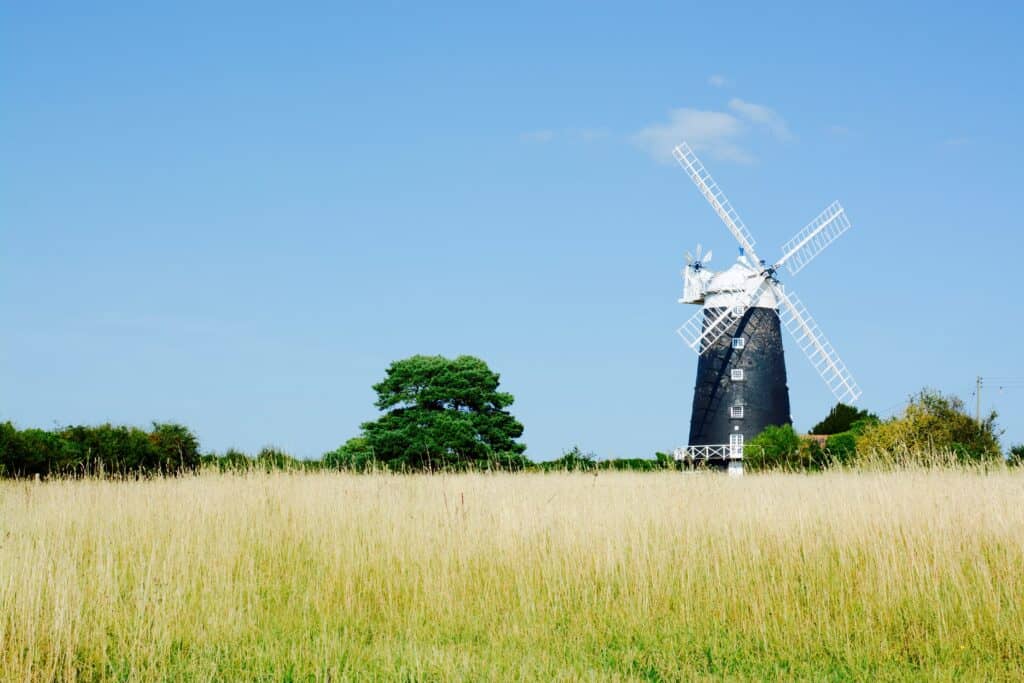
Marnie’s Mill
Have you read When Marnie Was There? It’s the story of Anna, a solitary London orphan sent to convalesce on the north Norfolk coast who meets a kindred spirit called Marnie in the mysterious Marsh House. Published in 1967, this ghostly tale of a little girl’s loneliness was shortlisted for the prestigious Carnegie medal and is still a much loved children’s classic. Studio Ghibli made an anime film version in 2014, on the suggestion of Hayao Miyazaki, the great animator known for his love of European landscapes. In the film the story is relocated to rural Japan, but the softs tones of Norfolk’s timeless marshland are beautifully rendered. The fictional village in the book is named Little Overton but if you wander round Burnham Overy Staithe you’ll be immersed in Marnie’s world. Author Joan G Robinson spent family holidays here, inspired by the evocative landscape of meadow and marsh where the sky is ‘grey as a pearl’. You can see the red brick Granary with its blue door, the real life Marsh House, and a black and white windmill that’s stood here for over 200 years, just like the one that haunts Marnie’s imagination – and ours.
Take time to absorb the atmosphere of Burnham Overy Staithe. Walk the coast road and River Burn, surrounded by grasslands whispering in a salt breeze, bleached by lemony winter sunshine. Barn owls glide in the early dusk where crows repeat harsh cries. Time to turn in, get cosy and rediscover a childhood classic.
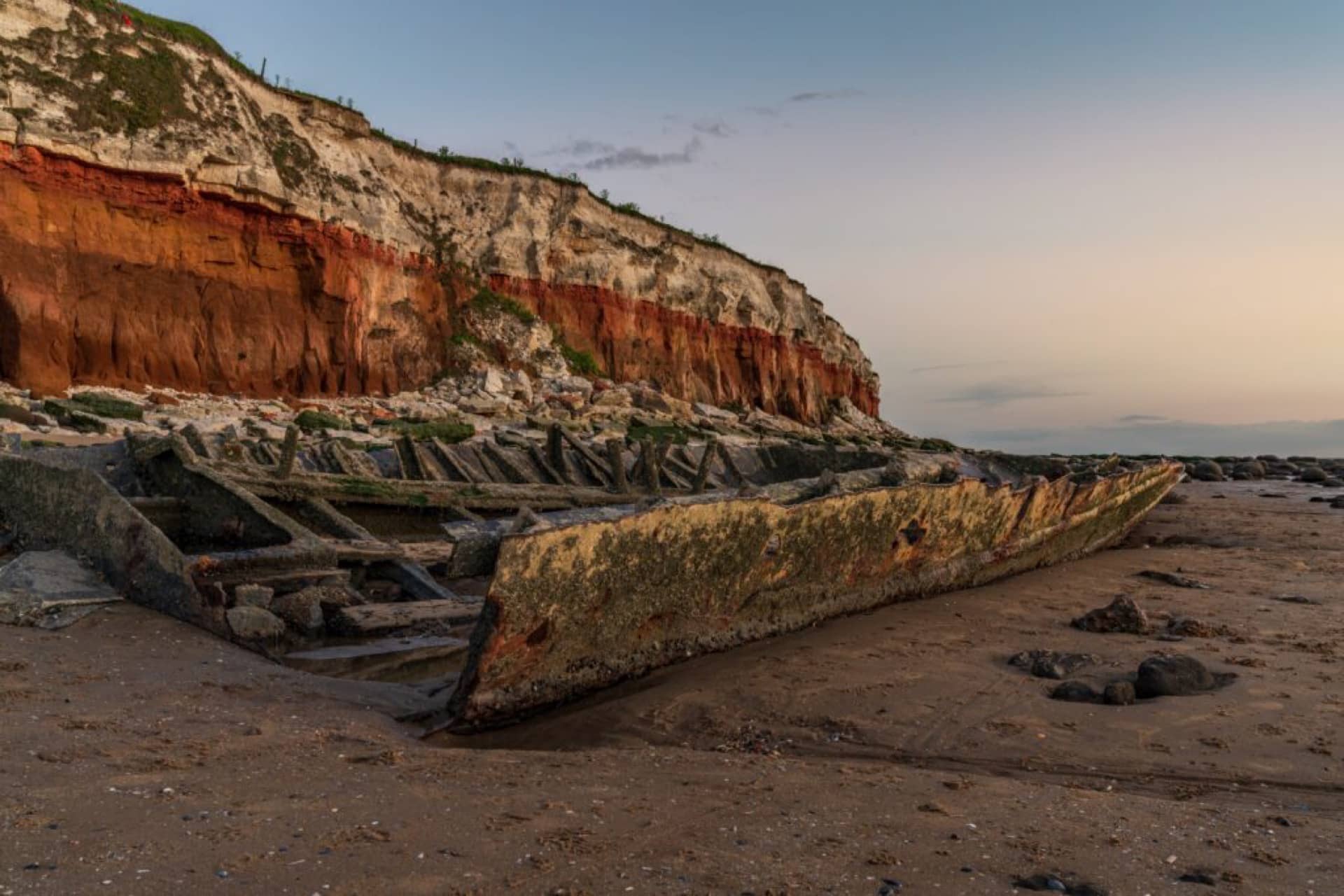
Rock & Roll
When the tide retreats, the sea reveals its secrets. At St Edmund’s Point near Old Hunstanton, the skeleton of the Sheraton lies in its last resting place on a bed of sand and rock, worn to the bone by waves and weather. Like all ships wrecked on the Norfolk coast, this once sturdy old steam trawler has its own story.
The Sheraton was built as a fishing vessel in Beverley, Yorkshire in 1907, designed to withstand the ruthless power of the North Sea when her crew set their nets off Grimsby. When the First World War broke out she was requisitioned by the Royal Navy and used for anti-submarine defences. And in the Second World War the Sheraton was busy serving her country again, now fitted with a six-pounder gun to patrol the waters of the North Sea coast. After the war she was painted daffodil yellow and used as an RAF target ship.
The Sheraton made her final voyage on the night of 23rd April 1947 when a wild gale howled in. Caught in the storm, the Sheraton broke her moorings off Lincolnshire, blew across the Wash and smashed into rocks in the shadow of Hunstanton’s striped cliffs.
Many years later, punk band The Stranglers rolled into town to pose on the beach near the remains of the Sheraton’s rusty rib cage, using Norfolk’s only rocky cliff as a backdrop for the cover of their aptly named album ‘Norfolk Coast’.
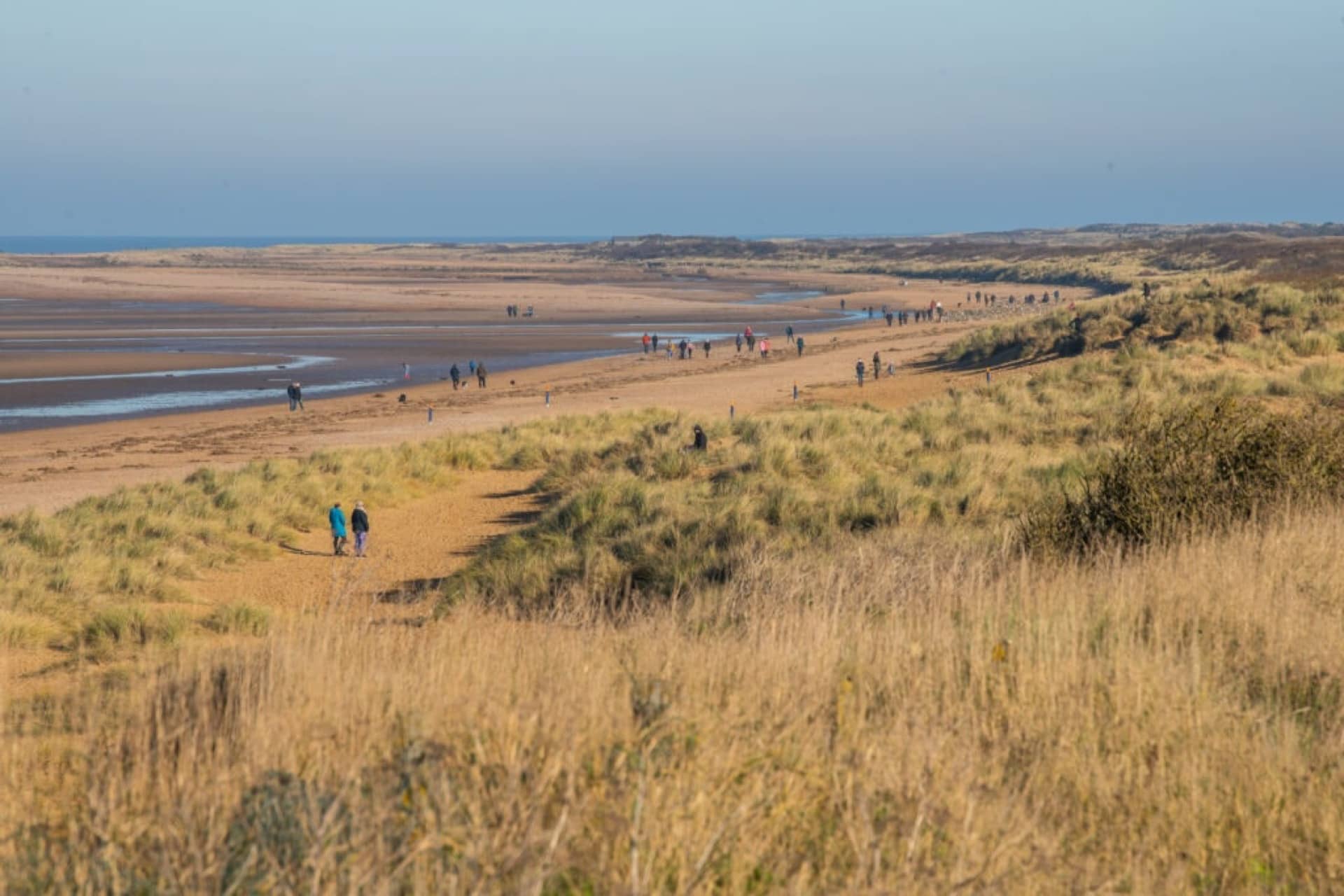
A Victorian Vision
Thousands of holidaymakers have memories of this handsome seaside resort, but not so long ago there was no town here at all.
Hunstanton was the vision of fabulously named Henry Styleman Le Strange, Victorian entrepreneur and landowner who developed part of his Norfolk estate as a coastal holiday village in the mid-19th century. You’ll see him on Upper Green at the start of your walk, an imposing bronze statue, proudly surveying the town he never saw in his lifetime.
His son, Hamon, took on the project after Henry’s death in 1862. Toast them both at the Golden Lion Hotel, Hunstanton’s first building, designed by Decimus Burton, renowned architect of Hyde Park, London Zoo and Kew Gardens.
It’s not signposted, but this circular walk is easy to follow with a map. Start at Le Strange’s statue. The train tracks round his feet to the success of ‘Sunny Hunny’. Head from Upper Green along North Promenade, up toward the distinctive striped cliffs, which featured in the 2021 film ‘Spencer’. Then onto the Norfolk Coast Path, past the ruin of St. Edmund’s Chapel and Hunstanton Lighthouse to Old Hunstanton and St. Mary’s Church, where Henry and Harmon lie buried. Finally, head back into town through the pretty picture postcard Esplanade Gardens.
Dodge the summer crowds and visit as a winter afternoon flares to dusk or on a morning in early spring to enjoy Hunstanton as Henry must have seen it, fresh and full of promise.
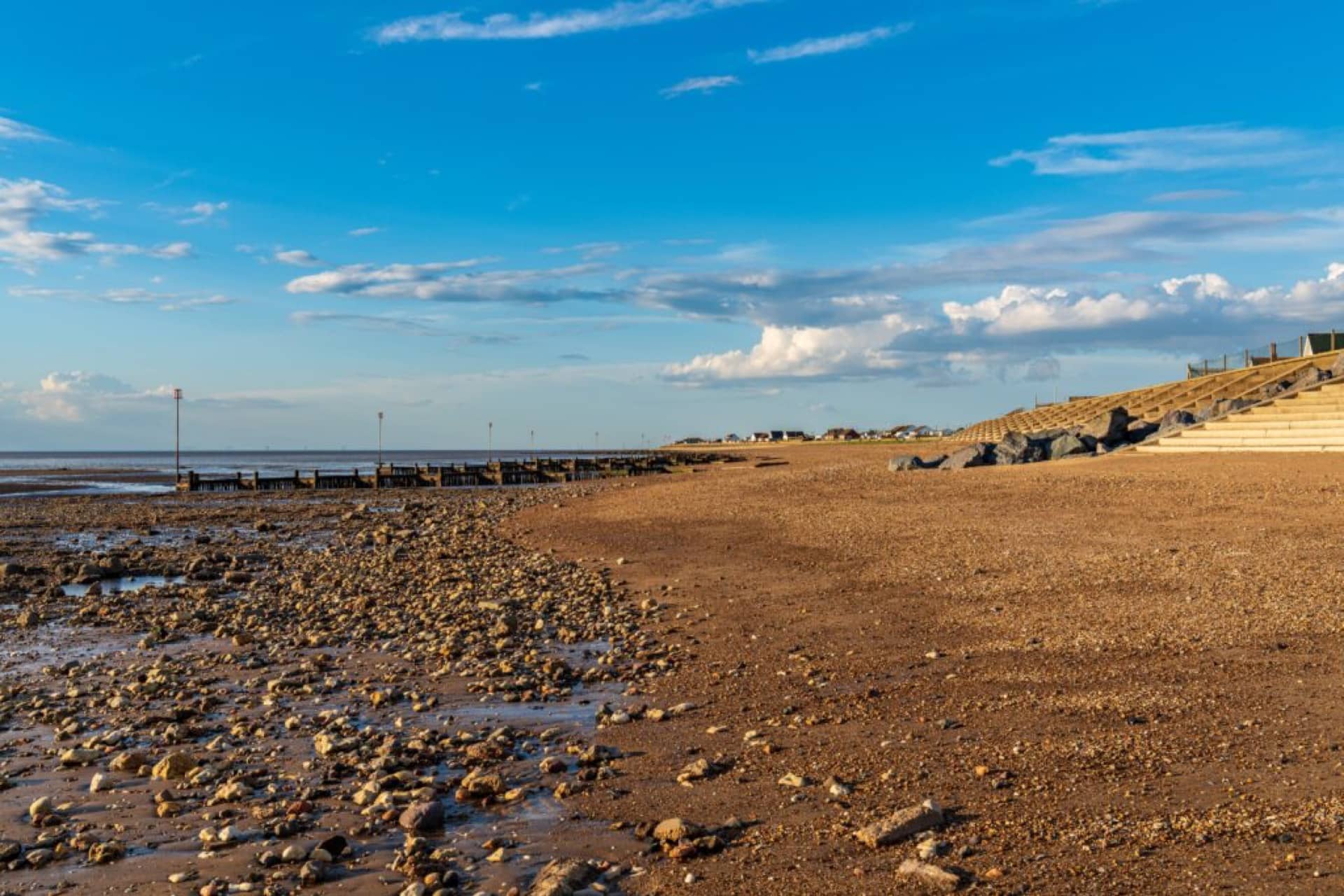
Heroes and High Water
The village of Heacham is one of the few places in eastern England where you can watch spectacular sunsets over the sea. However, on Saturday 31st January 1953, local people were troubled by a strange yellow tinge to the winter twilight. Little did they know what horror was coming. Strong winds blew up, the temperature plunged and a churning storm tide surged in, a terrifying 2 ½ metres higher than usual.
Swollen rivers burst their banks. Roads turned to rivers, fields to lakes. Train tracks and cottages were destroyed. The North Sea surge rose over 5 metres (18 ft) above average, devastating the British east coast, the Netherlands and northwest Belgium.
This catastrophic event was the worst natural disaster in British modern history. 9 people drowned in Heacham, 9 in King’s Lynn, 25 in Snettisham and 22 in Hunstanton, commemorated by a plaque at Hunstanton Heritage Gardens.
Locke Hill Farm (PE31 7QZ) was used as a local rescue base. Brothers, Stanley, Eric and Noel Linge, searched tirelessly for survivors with PC Henry Nobbs, tying ropes to telegraph poles so the flood water couldn’t sweep them away. PC Nobbs later received the British Empire Medal for bravery.
The Snettisham Circular Walk passes along the seafront, up Beach Road and past Locke Hill Farm. From the edge of the Lodge Hill woodland there are dramatic views toward the beach. Can you imagine these peaceful fields utterly consumed by the raging black sea waters of the 1953 storm?
Build your own itinerary
If you fancy creating your own itinerary for a day trip to Norfolk or a longer visit, it couldn’t be simpler. Just go to Search Activities and select from our wide range of free and paid-for experiences, saving any that capture your imagination with the click of a button.
Once you’ve finished, you’ll find all the information stored in My Favourite, where you can drag and drop activities to create your own day-by-day itinerary! You can download this to a calendar and even share it with friends.
